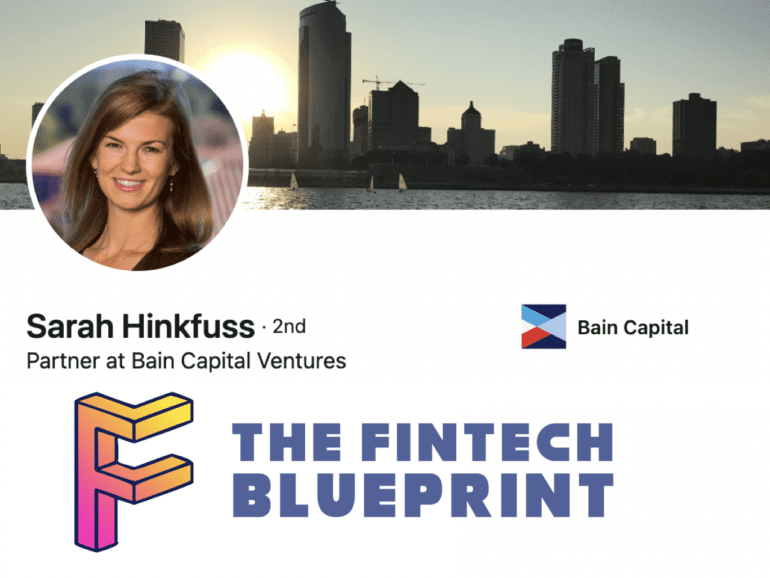The landscape has become increasingly challenging for startups. Funding cuts, plummeting valuations, and a shift from the “growth at all costs” mentality have left their mark.

In Fintech Blueprint’s second Office Hours roundtable, Sarah Hinkfuss, Partner at Bain Capital Ventures, shared insights on the startup stories that are enduring value through the volatile landscape.
The lively discussion that ensued with the Fintech Blueprint community spanned from startup navigation through the challenging climate to insight into how innovation in GenerativeAI may affect the space.
The Fintech Formula
The lull in the current market comes after a chaotic boom in financial services, loaded with promise. Business models were copied and pasted without much thought to differentiators and individual value. What we are experiencing now is a return to normalcy and a period of consolidation of core ideas, where growth is not as intense but still retains its upward momentum.
Earlier this year, Sarah and the Bain Capital Ventures team published extensive research on the core drivers of resilient value among publicly-traded fintech companies. She found that certain business models, e.g. B2B, with software at its core and without a balance sheet component, as well as certain financial characteristics, e.g. profitable and with at least 70% gross margins, were more resilient. In this way, an investor can approach startups with detailed advice on how they can navigate difficult conditions and continue to grow.
A large component of the startups’ success can lie in the founder. In the financial services sector, there is a fine line in the area of domain expertise. While the best founders typically have enough time in their sector of focus to understand the regulatory and market contexts critical to make their startup a success, too much tenure can lead to acceptance of the status quo.
This could be critical to their success in navigating through economic challenges and adapting to ongoing innovation.
The US Consumer Credit Cycle
The macroeconomic conditions for credit startups remain uncertain. Earlier this year, all indications pointed towards a recession, and while predictions have lessened in severity, consumer market sentiment remains unclear.
One interesting bellwether to consider is the upcoming student loan repayment cycle. With this date looming, signals are mixed regarding consumer spending. While consumer debt will be reduced through the uptake of repayments, the payments of student loans usually have a direct effect on the growth of the GDP. Consumer funds going towards paying off debt could pull consumer spending out of the economy and potentially trade lower-interest debt for higher.
While this specific dynamic mainly affects B2C investors, all financial services companies are affected by significant shifts in the macroeconomy. Building a company within these challenging conditions is likely to take increased effort, innovation, and flexibility.
Generative AI and Innovation through the Downturn
Generative AI (GenAI) is complementary to the traditional development of AI, but its basis in language rather than rules creates a defining factor. Where traditional AI and tech innovation have remained unreachable to the average person, GenAI has a perceived humanity that people can relate to. This attribute, when used in financial services, could bring the often alien environment into a scope of understanding, creating an impact in areas like wealth management.
However, as the technology is based on language and is, by definition, generative, there is a wide margin for error. This may restrict the usage of GenAI to areas that don’t need 100% accuracy or as a tool complemented by human oversight to achieve 100% accuracy.
Within this first wave of GenAI technology, incumbents are likely to reap the most benefits over early-stage startups. Incumbents have the distribution, data, and resources to fully power and leverage GenAI models. This can put startups at a disadvantage. Service providers of GenAI could be key to maintaining startup competitiveness as demand for generative AI-powered products takes off.
The deployment of service providers can be particularly effective in the banking sphere. Small banks that perhaps don’t have the resources of the megabanks to develop their own generative AI products may need to turn to AI service providers to remain competitive.
Banking disruptors that focus on an underserved market can build their base and their underlying technology before launching into mainstream banking and taking on incumbents. While this is a story that has driven the success of many neobanks, the strategy is still playing out.
Within a possible scenario where the use of GenAI service providers could lead to a lack of differentiators, targeting underserved markets that aren’t typically attractive to incumbents with these solutions could be key to ongoing success. The collective move of financial services through the early stages of GenAI adoption could spark a multi-institutional understanding of its applicability, developing the technology through previously unobserved applications.


